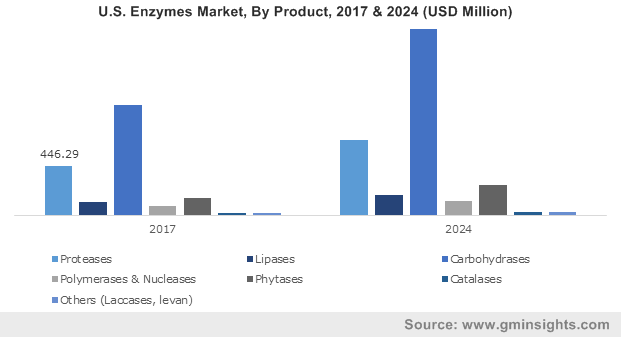Global enzymes market remuneration to cross the 10-billion-dollar mark by 2024, animal feed applications to drive the industry landscape
Publisher : Fractovia | Latest Update: March 2019 | Published Date : November 2016Request Sample
Rising population and advancing methods of industrial production will considerably reinforce the global enzymes market, which has key applications in the food & beverage, textile, cosmetics and animal feed segments. Enzymes help improve the nutritional value of food items and also extend their shelf life, boosting demand for the substance. Continuous increase in the consumption of packaged food will subsequently propel revenues for the enzymes industry, further enhanced by its importance in the production of nutraceuticals, dairy and fruit juice products.
U.S. Enzymes Market, By Product, 2017 & 2024 (USD Million)

The industry is also finding its place in the processing of bio fuels as well as in wastewater treatments, owing to the beneficial chemical properties of enzymes. The substances have also proven vital in improving the digestion among livestock animals and raising their health standards, suggesting that augmented meat and poultry intake will create tremendous opportunities for the enzymes market.
As of February 2019, more than 49.3 million tons of meat had been eaten worldwide already in the year, with the number increasing continuously by every passing second. Massive areas of land and a mammoth amount of animal feed are required to maintain the cattle and other livestock animals which are being raised for the purpose of food production. Therefore, it is necessary to ensure the animals are provided with high-quality nutrition, while rising concerns about energy footprint need to be tackled with more efficient ways to optimize animal production. In this regard, enzymes like carbohydrase, phytases and protease deliver various benefits to the animals and the producers, unveiling a crucial end-user segment for the enzymes industry.
Elaborating further, experts have stated that a corn-soybean animal meal, which is said to be the standard diet for swine and poultry and consists of highly digestible base ingredients, is still only 85% digestible. The remaining quantity of these costly ingredients not only remain unutilized in the animals, but also cause problems such as diarrhea and gut irritation, negatively affecting nutrient absorption. The enzymes market has witnessed a surging demand for animal feed producers to ensure higher efficiency of ingredient digestion, with different enzymes providing different benefits to the livestock diets. Apparently, enzymes can lower the cost of diet effectively, enhance the nutrient release in the feed as well as reduce cost per pound of the meat.
To comprehend the importance of providing a healthy animal food product, consider the fact that the U.S. Department of Agriculture had estimated the consumption of poultry and red meat will reach an average of 222.2 pounds per person in 2018. The enzymes industry would be able to provide solutions to animal producers for reducing phosphorus excretion and improving the environmental footprint emerging from livestock. It was reported that nearly half of the world’s harvest is directed towards feeding animals, which indicates the vast application potential of the enzymes market within the animal feed industry. Enzymes, in essence, help to produce uniform growth among livestock and also increase the profitability for the producer by cutting down feed costs.
Separately, a large number cases pertaining to consumption of unhealthy animal products and packaged meat food has driven governments to pressurize animal producers to stop the use of growth-inducing drugs and chemicals. Supplementing animal diets with enzymes has been preferred more commonly now as an approach to counter this issue. The enzymes industry will experience accelerated growth over the coming years with the need to naturally enhance the quality and output of animal-sourced food products. By 2050, the meat consumption is anticipated to grow by 160% worldwide due to the exponentiating population, offering remarkable prospects for the enzymes market from the animal feed segment. Lifestyle trends affecting the demand for high quality protein diet to improve and maintain physical health will also stimulate development of the animal feed industry.
All in all, expanding consumption of poultry, meat and other animal products will enormously proliferate the enzymes market, with the growing need for effective and low-cost feed additives. DSM, Danisco, BASF and Novozymes are some prominent companies leading the competitive landscape of the industry, offering numerous enzyme products to be deployed in animal feed production, food and beverage processing as well as development of nutraceuticals, among others.